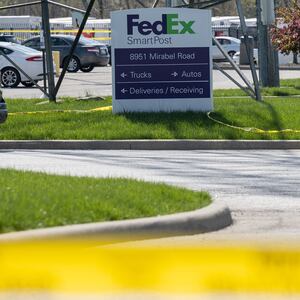One would think the charging of some 440 Capitol marauders would defang right-wing extremists. Likewise, their de-platforming on social media and the exit of the president who inspired them. Likewise, the splintering of groups like the Proud Boys and Oath Keepers, whose members have been rounded up by authorities for storming the citadel.
Nope. That won’t stop them.
Experts who monitor domestic terrorism say we’re heading into an even more dangerous phase post-Jan.6. These groups are fragmenting and losing the ability to vent frustration in a public manner. But that does not mean they are going away. It means that a lot of angry radicals are growing angrier.
“You will see a period of growth,” says Daryl Johnson, the former lead analyst for domestic terrorism for the Department of Homeland Security.
“The people on the outside periphery will likely distance themselves and get out of the movement. But the pool inside is going to be more hardcore and resolved.”
He predicts more violence during the rest of President Joe Biden’s term. And maybe for many more years after that. While we’re unlikely to see a mass event like Jan. 6 that brought together 10,000 people at the Capitol, there could be more local attacks on a smaller but maybe more lethal scale—car rammings, assassination plots, and bombings of state government buildings, infrastructure, or places where ordinary folks gather.
For sure, some of the core 1,000 who breached the Capitol are spooked by the legal consequences. But a sense of glory surrounding the insurrection and resentment will animate the more committed militants. While they’ve lost their megaphone in Trump, other politicians amplify his message in the mainstream political discourse. And more fodder exists for recruitment among right-wingers fearful of anti-gun legislation and the expansion of minority rights under a Democratic president. The stressors of the pandemic remain. People are socially estranged, under financial stress, and fearful of change. Gun sales have exploded since Jan. 6.
Shutting down accounts on Twitter, Facebook, or Parler doesn’t shut up extremists. They simply migrate to other spaces like the Telegram messaging system. Conversations are still happening among extremists who encourage each other to make trouble.
No one knows for sure how many combustible individuals lurk about, but militias number in the hundreds across the country. Johnson estimates there could be as many as 145,000 active members of anti-government groups including the Oath Keepers, Three Percenters, Boogaloo Boys, and Proud Boys. Add to that hundreds of thousands of white supremacists and millions of QAnon believers.
You just need a handful of guys willing to get into risky situations, like the six militia members charged last year with plotting to kidnap Michigan Gov. Gretchen Whitmer.
And there are certainly a lot of guns circulating with which to create trouble. For the second year running, firearms sales have hit record numbers so far this year. According to the FBI, March 15-21 alone posted the highest number of weekly background checks—more than 1.2 million—since 1998.
Oren Segal, vice president of the Anti-Defamation League’s Center on Extremism, worries most about individuals with violent tendencies who aren’t necessarily card-carrying members of a paramilitary. Sometimes a cluster is just a couple of buddies who meet in someone’s basement.
Of the first 257 people charged in federal court for taking part in the Capitol insurrection, only 33 percent were identified with a militant network, according to a study by the George Washington University Program on Extremism. That means the vast majority were unaffiliated but motivated by the pro-Trump narrative.
“The less organized they are, the more dangerous they are,” Segal says. The FBI can more easily infiltrate an organization like the Oath Keepers, which draws members from the military and law enforcement. But with groups like the Proud Boys splintering, rogue members are harder to monitor. Networks that break up can realign under so many different names that it’s impossible to keep track.
Then there are the lone actors. They could be socially isolated but very much part of a wider ideological community that exists online.
Some of the most violent events we’ve seen in recent years were perpetrated by self-radicalized gunmen who operated on their own. They didn’t belong to a given group. The shooter who killed 23 people at an El Paso Walmart in 2019. The gunman who slaughtered 11 people at Pittsburgh’s Tree of Life synagogue the year before. Dylann Roof, who fatally shot nine African Americans at a Charleston church in 2015.
These individuals may act alone but think they have people behind them, notes Arie Kruglanski, a University of Maryland professor of psychology who studies radicalization. Mass shooters know they will be remembered. Their “community” can be assumed or imagined. The white supremacist who killed 70 people in Norway in 2011, for instance, believed he was a protector of the race, even if he didn’t consult anyone else.
“The lone wolf is not as lonely as it appears,” Kruglanski warns.
Last year saw a notable absence of mass killings, probably as a function of the pandemic. The opening of public spaces, however, has coincided with at least 147 mass shooting incidents that have killed 166 so far this year. We are likely to experience even more mass slaughter that is politically motivated, predicts Brian Levin, the director of the Center for the Study of Hate and Extremism at the California State University, San Bernardino.
We may also see a diversification of targets from minority groups to political figures, reporters, and public health officials. Extremists have many grievances—land use, guns, COVID restrictions, unemployment, loss of status. They may confuse or conflate different issues as they chat with others online.
“You have highly volatile people who can be picked up by a variety of conspiracies and movements with violent leanings,” Levin says. “That’s a big reservoir to swim in.”
Geographic data on arrests so far could provide clues into where trouble might flare next. A study by the Chicago Project on Security and Threats found that over half of the Capitol rioters who converged from 42 states came from counties that President Joe Biden won. This smashes the common assumption that the Trump fans who resort to violence would mainly hail from his strongholds. In fact, more came from cities and suburbs where they were in the political minority, and thus probably felt marginalized. The largest numbers came from Florida, Pennsylvania, Texas, New York, and California—all places with racial diversity.
These numbers coincide with geographic trends in hate crimes and racist violence examined by Arie Perliger, the director of Security Studies at the University of Massachusetts, Lowell. The same blue states crop up in attacks on minorities or synagogues. Perliger says most incidents before Jan. 6 occurred not in the deep red South but in rural and suburban areas of blue states that have the highest levels of diversity. New York, Pennsylvania, Illinois, California, and even Massachusetts. Spot the pattern here?
Of the more than 650 violent incidents between 1990 and 2017, Tennessee suffered just 80. California had more than 900 incidents and Illinois over 200.
“In these kinds of states, the polarization and animosity are more toxic,” explains Perliger. In Alabama there is little divide; it’s overwhelmingly conservative. But New York state poses more toxic potential due to the split between the blueish New York City and the reddish upstate.
Anxiety about the economy also fuels xenophobia against growing Hispanic and Asian populations, which are viewed as competition in the labor market, he notes,
Here’s what we need to look out for: states like Georgia that tipped blue, where there is change, demographically and politically. Is there a particular issue that makes right-wingers feel under siege? Is there a charismatic rabble rouser? Study where violent incidents occurred pre-Jan. 6. Last year, Trump supporters stormed state capitols in Oregon and Michigan. In response to lockdowns and restrictions, armed protests flared in Ohio, Kentucky, California, Arizona, and Virginia. These could be hot spots in the months ahead.
Judith Matloff teaches conflict reporting at Columbia’s Graduate School of Journalism. Her latest book is How to Drag a Body and Other Safety Tips You Hope to Never Need.







